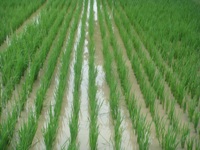|
Mole Cricket
| Symptom of Damage : |
- Loss of plant stand
- Seedlings cut at the base.
- Poor seedling growth.
- Seedling death.
- Missing plants.
- Root damages.
|
 |
 |
| Mole Cricket damage |
Mole Cricket feeding damage |
|
| Top |
| Identification of pest : |
|
Scientific Name - Gryllotalpa orientalis
- Egg :
Eggs are oblong to oval and gray with a shiny surface.They are 2.6 mm long. The eggs are deposited in a hole constructed by the adult female.
- Nymph :
Neonate nymph has a white and bluish prothorax and legs. With age, it turns gray to black with white markings. The last nymphal stage is similar to the adult except for its short wing pads.
- Adult :
The adult mole cricket is brownish and very plump. It measures 25-40 mm long. It has short antennae and its folded wings do not cover the entire length of the abdomen. The enlarged front legs, which are modified for digging, have strong teeth-like structures. |
 |
 |
| Mole Cricket |
 |
 |
| Mole Cricket |
|
| Top |
| Management Strategies: |
|
- Cultural control includes maintaining standing water, which can help to remove the eggs on the soil.
- The eggs can also be eliminated using bund shaving and plastering of fresh wet soil.
- Levelling the field provides better water control.
- Construction of a raised nursery should be avoided to reduce feeding damage on seedlings.
- For natural biological control, a sphecid wasp, carabid beetle, nematodes, and a fungus are recorded as important natural enemies of the mole cricket.
- Mole crickets eat each other when they are together because of their cannibalistic behavior.
- Poisoned baits made by mixing moistened rice bran and insecticide that can be placed along rice bunds can kill night-foraging mole crickets.
|
 |
 |
| Maintain Standing water |
Sphecid wasp |
| Top |
|








